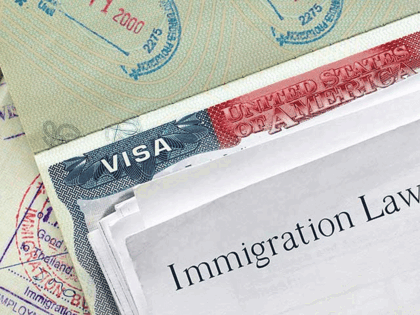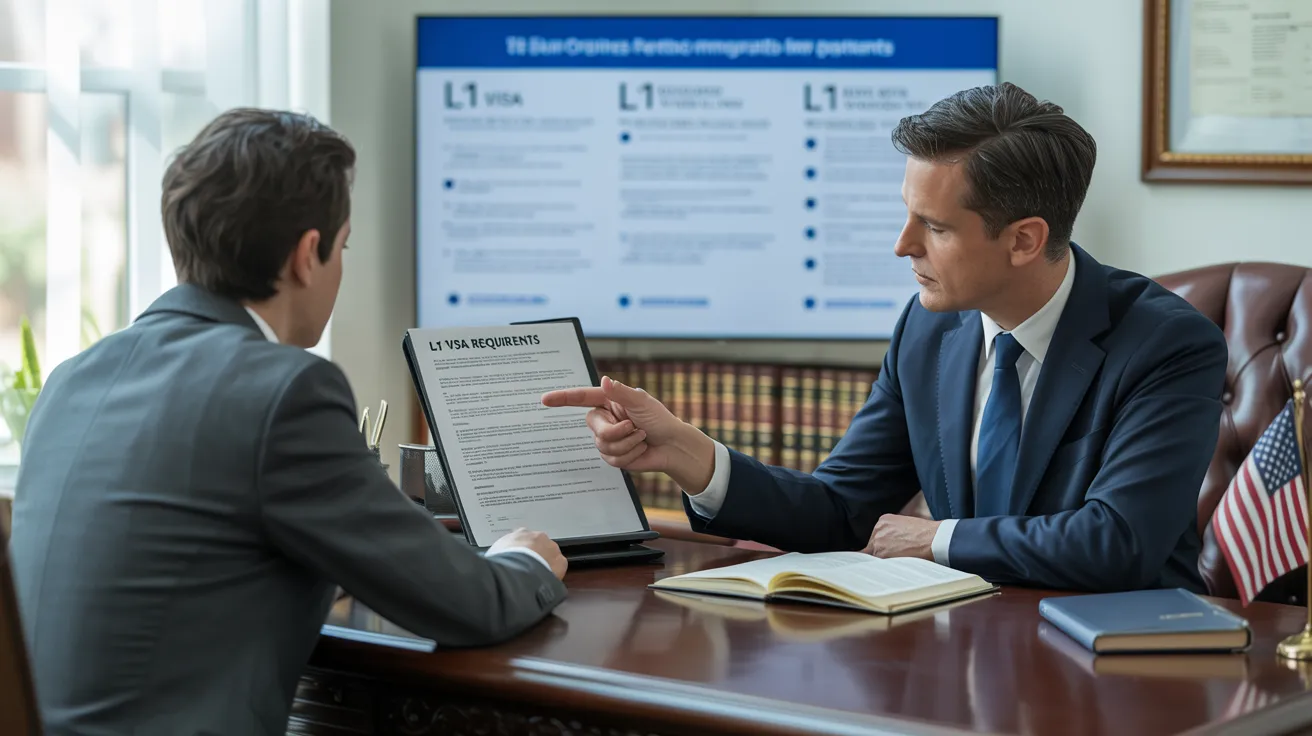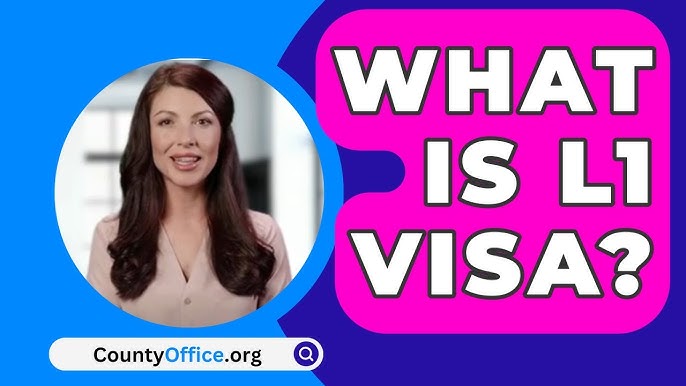Opening Opportunities: A Comprehensive Guide to the L1 Visa Process
The L1 visa process provides a vital path for multinational companies looking for to transfer key employees across borders. Recognizing the nuances of eligibility standards, the distinctions between L-1A and L-1B visas, and the intricacies of the application process can greatly affect an applicant's success. Nonetheless, maneuvering this complicated landscape is not without its difficulties, and mindful interest to documentation and company sponsorship is vital. As we check out the key components of this procedure, the strategies for getting rid of potential challenges will certainly end up being evident, disclosing how notified preparation can open up a globe of possibilities.
Recognizing the L1 Visa
Recognizing the L1 visa requires recognizing its importance as an essential tool for international business looking for to move skilled workers between worldwide offices. This non-immigrant visa group promotes the movement of executives, supervisors, and specialized knowledge employees to the USA, therefore making it possible for companies to keep functional connection and harness international ability successfully. The L1 visa is divided right into 2 main categories: L-1A for managers and execs, and L-1B for staff members having specialized knowledge.The L1 visa serves an essential function in enhancing a business's one-upmanship in the international industry - L1 Visa. By allowing companies to move their vital workers, services can guarantee that essential tasks are managed by qualified people that are currently knowledgeable about the business's society and functional processes. This interior transfer device not just fosters knowledge sharing however also promotes technology and cooperation across borders.Moreover, the L1 visa is frequently preferred for its relatively simple application procedure contrasted to other visa classifications, as it enables double intent, permitting holders to go after irreversible residency while on a short-term job visa. This function makes the L1 visa especially appealing for both employers and staff members, as it simplifies the pathway for knowledgeable professionals to establish long-term residency in the United States
Eligibility Requirements
Qualification for the L1 visa rests on numerous essential standards that ensure both the worker and the employer fulfill details qualifications. This non-immigrant visa is developed for international firms to transfer workers from consular services to united state counterparts.Firstly, the employer must be a qualifying organization, which consists of a moms and dad firm, branch, affiliate, or subsidiary of an U.S. organization. The business needs to have been doing company for at least one year both in the united state and abroad. This assures that the firm has sufficient functional stability and a reputable presence.Secondly, the staff member must hold a supervisory, exec, or specialized expertise position. For L1A visas, the candidate must demonstrate managerial or executive certifications, while L1B visas focus on specialized expertise related to the organization's items, solutions, or processes. Additionally, the staff member needs to have functioned for the international entity for at least one constant year within the last three years prior to their application.Lastly, the staff member's function in the united state must align with their previous placement, making certain that their abilities and know-how are leveraged for the business's advantage.
Kinds of L1 Visas
The L1 visa category consists of two main kinds developed to facilitate the transfer of workers within international companies: the L1A visa for managers and execs, and the L1B visa for employees with specialized knowledge. Each kind serves distinctive functions and has specific eligibility criteria.The L1A visa is customized for people that hold supervisory or executive settings within a firm. This visa makes it possible for high-level staff members to move to an U.S. branch, subsidiary, or affiliate of the very same organization. Candidates for the L1A visa need to show that they have actually been employed in a supervisory or executive capacity for at the very least one continuous year within the previous three years before their application. Furthermore, this visa supplies a longer duration of keep, at first given for three years, with the possibility of expansions for as much as seven years.In contrast, the L1B visa is planned for specialists with specialized knowledge associated to the company's items, services, or processes. To qualify, candidates should show that their know-how is vital to the organization and that they have worked for at least one continuous year within the last three years in a role that needed this specialized understanding. The L1B visa is initially approved for three years, with extensions available for as much as five years.Both visa types are vital for business seeking to boost their worldwide procedures by leveraging skilled employees, thus advertising advancement and performance within the U.S. market.
Application Process
Steering with the L1 copyright process involves a number of vital steps that need to be diligently complied with to ensure a successful outcome. The process begins with the U.S. company, that have to first establish qualification by showing a certifying relationship with the foreign entity and confirming that the worker fulfills the details needs for the L1 visa classification being sought.Once qualification is validated, the employer starts the procedure by submitting Type I-129, the Application for a Nonimmigrant Worker, with the U.S. Citizenship and Migration Services (USCIS) This type must be accompanied by a detailed description of the job obligations to be carried out, the organizational structure of both the united state and international entities, and the employee's credentials. It's important to verify that all information is exact and total, as omissions or errors can lead to hold-ups or denials.Upon approval of the I-129 petition, the following step involves the worker obtaining the L1 visa at an U.S. consular office or consular office in their home country. This phase requires the completion of Form DS-160, the Online Nonimmigrant copyright, and arranging an interview. Throughout the meeting, the candidate must offer evidence sustaining their credentials and the employer's petition.After the visa is approved, the staff member can get in the United States to function in the designated function. Overall, mindful preparation and adherence per step of the application procedure are important for an effective L1 visa outcome.
Needed Paperwork

Necessary Kinds Required
Steering the L1 Visa procedure needs careful interest to the vital forms and documents required for an effective application. The main form needed is the Form I-129, Petition for a Nonimmigrant Employee, which need to be completed and sent by the united state employer. This type outlines the information of the work offer and the credentials of the staff member seeking the L1 Visa.Alongside Type I-129, the candidate will require to complete Form I-539 if going along with relative are additionally obtaining visas. Additionally, the company must offer evidence of the qualifying partnership between the united state entity and the international entity, often requiring the entry of corporate papers such as short articles of unification or financial statements.Moreover, it is necessary to consist of the L Classification Supplement to Kind I-129, which defines the sort of L Visa being requested-- either L-1A for supervisors and executives or L-1B for workers with specialized expertise. Finally, candidates ought to assure that all kinds are signed and dated appropriately, as insufficient submissions can result in delays or denials. Appropriately setting up these essential kinds lays the structure for a smoother L1 copyright process.

Supporting Evidence Requirements
Supporting paperwork is essential for an effective L1 copyright, as it corroborates the insurance claims made in the petition. Applicants must provide an array of records to demonstrate qualification for the visa, which is classified into two primary types: evidence of the certifying connection in between the U.S. and international entities and proof of the candidate's qualifications.To develop the partnership, applicants need to submit paperwork such as company business charts, economic declarations, and proof of possession. These papers validate that the foreign firm has a certifying relationship with the U.S. company, whether as a parent firm, subsidiary, branch, or affiliate.For the applicant's qualifications, important documents consist of a thorough employment letter from the foreign employer, laying out the applicant's job title, responsibilities, and period of employment. In addition, educational qualifications, such as degrees and diplomas, must be provided to verify the applicant's experience in the relevant area.
Company Sponsorship Records

Typical Challenges
Steering the L1 visa process presents numerous common obstacles that applicants must be aware of. Trick concerns commonly include stringent paperwork requirements, possible hold-ups in processing times, and the requirement for rigorous legal conformity. Comprehending these obstacles can help candidates better prepare and alleviate risks during their copyright journey.
Documentation Needs
The L1 copyright procedure typically provides substantial difficulties associated with documentation needs. Applicants should offer extensive paperwork to develop eligibility, which can cause confusion and prospective hold-ups. Trick documents include proof of a qualifying partnership between the U.S. and international employer, proof of the candidate's work history, and thorough details concerning the work role in the U.S.One common challenge is gathering sufficient evidence to demonstrate the nature of the qualifying connection. Business usually struggle to existing clear business charts or financial statements that show the connection between the entities. On top of that, making sure that letters of assistance from companies accurately mirror the candidate's task obligations and certifications is important, as vague descriptions can lead to denials.Another issue develops from the requirement for detailed work descriptions that align with the L1 visa categories. Candidates have to express not just their current role however likewise their managerial or specialized knowledge responsibilities clearly. This necessitates an extensive understanding of both the applicant's placement and the regulatory language used in L1 applications.
Processing Time Hold-ups
Experiencing hold-ups in processing times is a typical challenge encountered by L1 visa candidates, commonly leading to disappointment and unpredictability. A number of factors add to these delays, consisting of high application volumes, increased examination of applications, and administrative stockpiles within the U.S. Citizenship and Immigration Services (USCIS) Candidates might discover that handling times can differ considerably depending on the service center managing their application, as each facility has its very own work and effectiveness levels. In addition, the complexity of the applicant's situation, such as the demand for comprehensive paperwork or explanation, can additionally extend wait times.In some instances, issues connected to the candidate's present migration condition or previous visa background may additionally lead to extra read more hold-ups, as USCIS might require further evaluation or details. It is essential for candidates to remain aggressive during this period, keeping open communication with their employers and lawful agents to address any type of potential problems promptly.Understanding these handling time difficulties can assist L1 visa candidates get ready for possible delays and alleviate the influence on their change and occupation strategies. Perseverance and diligence are vital virtues in steering this intricate process.
Legal Compliance Issues
Lots of L1 visa applicants come across lawful compliance issues that can complicate their journey toward obtaining the visa. Understanding and sticking to the particular laws set by the united state Citizenship and Immigration Provider (USCIS) is crucial. Typical obstacles consist of demonstrating the certifying relationship in between the international and united state employers, in addition to confirming that the applicant possesses the requisite specialized knowledge or supervisory capacity.Additionally, applicants should offer complete paperwork outlining their task obligations, company framework, and monetary practicality of the united state entity. Insufficient or unreliable paperwork can result in hold-ups or even denials. Employers should also guarantee that they adhere to labor legislations, consisting of wage and functioning problem requirements, which can affect visa eligibility.Another typical issue involves preserving compliance with the terms of the visa once approved. Modifications in employment condition, job responsibilities, or company framework can necessitate amendments to the visa, which otherwise resolved promptly can lead to lawful issues. Because of this, remaining informed about conformity demands and seeking lawful advise when required is important to browse the complexities of the L1 visa procedure successfully.
Tips for Success
Success in the L1 copyright procedure often rests on meticulous prep work and interest to information. To improve your opportunities of approval, begin by completely understanding the eligibility needs for both the L1A and L1B visa categories. Examine whether your position at the company qualifies as managerial, exec, or specialized expertise, as this categorization significantly affects your application.Next, collect comprehensive documents that corroborates your claims. This includes organizational charts, thorough job descriptions, and evidence of the business's operational framework. Clear and succinct evidence of the certifying partnership between the united state entity and the international entity is important. Validate that all documents are organized realistically and provided in a professional way, as this mirrors your dedication and severity about the application.Engage the services of an experienced migration lawyer that specializes in L1 visas. Their experience can prove very useful, guiding you through complicated laws and guaranteeing that all documents follows present regulations. In addition, prepare for the interview by practicing response to typical inquiries and being all set to review your function and contributions to the firm comprehensive.
Often Asked Questions
Can Household Members Accompany the L1 Visa Holder?
Yes, family members of L1 visa owners, including partners and single youngsters under 21, can accompany the main visa holder. They may likewise make an application for L2 visas, which enable them to live in the USA.
For How Long Can I Remain on an L1 Visa?
The L1 visa allows initial stays of up to 3 years, with the possibility of expansion. L1A visa owners may remain for a maximum of 7 years, while L1B visa owners can stay for five years.
Can L1 Visa Owners Request a copyright?
Yes, L1 visa holders can apply for a permit. L1 Visa Requirements. They may seek permanent residency via employment-based groups, generally requiring sponsorship from their company, provided they fulfill the needed certifications and documents needs
What Happens if My L1 copyright Is Refuted?
If your L1 copyright is rejected, you may obtain a notification describing the reasons for denial. You can look for to appeal the choice, reapply, or explore different visa options based on your circumstances.
Exist Any Type Of Travel Restrictions With an L1 Visa?
An L1 visa generally permits international travel; nonetheless, re-entry to the U. L1 Visa.S. rests upon maintaining legitimate standing. Tourists must ensure conformity with visa problems to avoid complications upon return
Final thought
